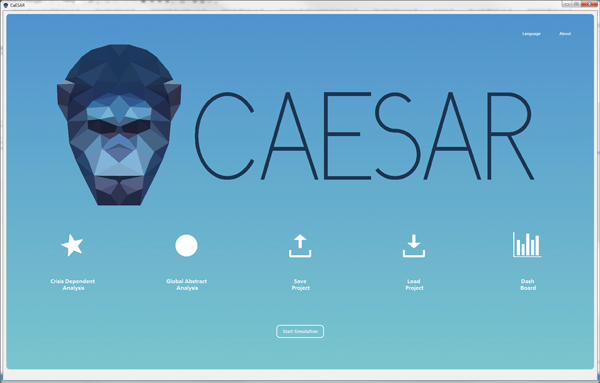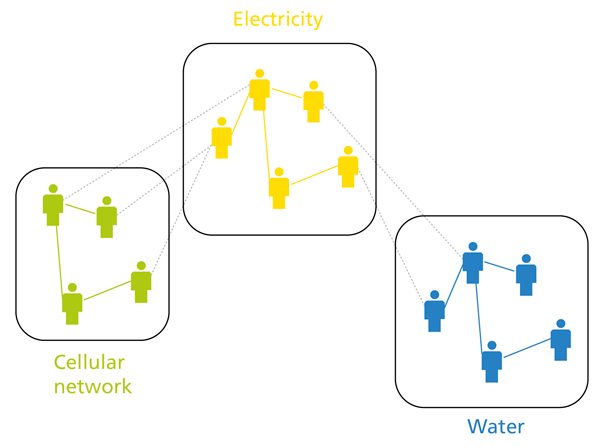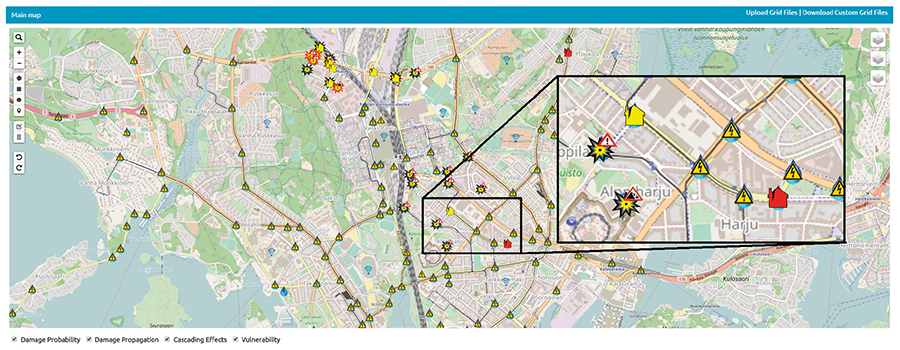


Modern supply networks are highly complex systems that are strongly dependent on other (critical) infrastructures. Disruptions in these networks can result in many diverse effects. For instance, power failure can lead to problems in the communication network or in the water supply network. An incident caused by a previous one is referred to as a cascade effect. These cascade effects, particularly those caused by instances such as natural disasters, can lead to fatal results for the public. It is thus essential to understand cascade effects in supply networks in order to minimize the possible results of natural disasters. Currently, cascade effects in supply networks as well as the interdependency of different infrastructure networks are being analyzed through simulations at Fraunhofer EMI. As part of the project “Snowball”, researchers at EMI have developed the software tool CAESAR (Cascading Effect Simulation in Urban Areas to Assess and Increase Resilience), cf. Figure 1. The goal of CAESAR is to provide solutions for a more robust, interconnected infrastructure that will help minimize problems caused by possible failures. For this, a deeper understanding of cascade effects is necessary. CAESAR can expose different infrastructure networks (such as power networks, water supply networks and cellular networks) to a fictitious natural disaster in a computer simulation. The CAESAR software estimates how much primary damage is caused by natural disasters, e.g. a utility pole falling over. The simulation then propagates the damage caused by the entire supply network. Two forms of cascade effects are considered: first, the propagation of a failure within the same network (for instance, if a utility pole falls over, this may lead to a disruption of power supply of a substation) and second, the propagation of a failure beyond the boundaries of that network (for example could the failure of electrical supply lead to a disruption of mobile phone base stations). New methods for an increased resilience of supply networks can be developed based upon these simulations. CAESAR can propose new strategies that could help minimize cascade effects, particularly those on dependent critical infrastructures. The results are presented on a website through a Geographic Information System (GIS).
Calculation of Resilience
The following methods are required for the simulation of network dependency. A form of modelling, using a multi-agent system, which combines the different infrastructure networks (electricity, water and cellular networks) is an important example. Physical dependencies between the different infrastructures are displayed as probabilities (Figure 2). By using these dependencies, it is possible to calculate to what extent, for example, power outages influence the functionality of the water and cellular networks within simulations. In order to mitigate or reduce these inter-infrastructure failures, certain methods for identifying potential weak spots were developed. On the one hand, they are based on an analysis of the network structure and on the other hand, on a simulative estimation of the extent of failures. With that, CAESAR can determine which parts of the infrastructure contribute to the cascade effect. Based on these identified critical parts, CAESAR then provides possible strategies to increase the robustness against the cascade effects mentioned before. Certain measures, which encompass the resilience of interconnected infrastructures against cascade effects, form the basis for this. These resilience measures reflect possible effects of functionality loss caused by network failures as well as the possibility to restore full functionality. Thus, the software can determine how resilient interconnected infrastructures really are in the face of a natural disaster. Based upon that determination, strategies leading to the best possible increase of resilience against cascade effects can be provided.
Calculation results from CAESAR
CAESAR presents the calculated results on a website using a GIS (Figure 3). The figure shows which parts of the infrastructure have failed. In addition, various symbols are used to visualize at which infrastructural parts the failure was propagated to another infrastructure, what type of failure was experienced, and what the possibility of a failure in the simulation is. The symbols in Figure 3 are marked with a red triangle.
Beyond the failures, those parts of the infrastructure that largely contribute to the cascade effects are depicted. These parts are represented by either a yellow or a red symbol (Figure 3). Yellow symbols depict critical parts, red symbols depict very critical parts. For these parts of the infrastructure, CAESAR calculates possible resilience strategies, such as adding redundancy or installing an independent power supply. With the CAESAR software, it is possible for the user to analyze how a natural disaster affects interconnected infrastructures, in which areas failures caused by cascade effects are most likely to be expected, and in which areas the critical infrastructural parts are located. Through these analyses as well as the suggested measures of improvement, a user can determine where an increase in resilience will have the greatest positive effect on the stability of the infrastructure.